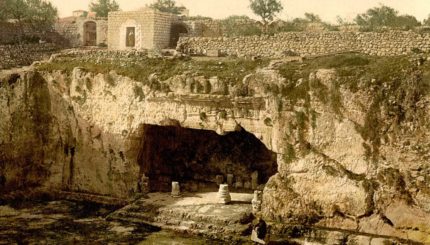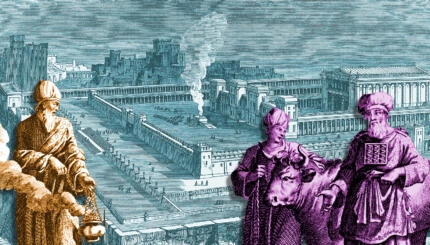Jews living under Christianity–in places like Rome, Worms, Cracow, or, after, 1248, Spain–were subject to two different ruling powers: the church and the state. The following article describes the relationship among these entities in the Middle Ages. It is reprinted with permission from Eli Barnavi’s A Historical Atlas of the Jewish People, published by Schocken Books.
It was during the central Middle Ages, between the First Crusade and the Black Death, that the Catholic Church defined its policy towards the Jews. Its attitude was based on the Augustinian doctrine which ascribed an historical mission to the Jews as witnesses to the truth of Christianity. Their existence within Christendom was portrayed as double testimony. As the original recipients of God’s messianic prophecies, and despite having rejected them out of blind wickedness, the Jews indirectly attested to the authenticity of these same prophecies. At the same time, their status as a despised nation, living in ignominy and misery, was testimony to God’s wrath and to the intervention of Providence, constantly penalizing them for having rejected Christ.
This theological approach implied an acceptance of the continued presence of Jews. Yet many tried to undermine this relatively tolerant leaning. Talmudic texts which stressed the supremacy of the Halakhah [Jewish law], as its decisions were not based on the dubious claim of supernatural inspiration, were exploited by learned [Christian] theologians.
 In the twelfth century, Peter Of Cluny (the Venerable) and the instigators of the “trial” against the Talmud in the following century, fulminated against the pretensions of the Jewish Law, denouncing it as an illegitimate, even diabolical, addition to the Scriptures. Post‑biblical Judaism, they said, could be defined as a form of heresy and therefore legitimately extirpated. But the Papacy cut short such ideas. There was no way in which the Church could condemn the Jewish notion of Oral Law and Tradition without compromising its own claim of being the sole interpreter of the Holy Scriptures.
In the twelfth century, Peter Of Cluny (the Venerable) and the instigators of the “trial” against the Talmud in the following century, fulminated against the pretensions of the Jewish Law, denouncing it as an illegitimate, even diabolical, addition to the Scriptures. Post‑biblical Judaism, they said, could be defined as a form of heresy and therefore legitimately extirpated. But the Papacy cut short such ideas. There was no way in which the Church could condemn the Jewish notion of Oral Law and Tradition without compromising its own claim of being the sole interpreter of the Holy Scriptures.
With your help, My Jewish Learning can provide endless opportunities for learning, connection and discovery.
Nevertheless, while it did adhere to the principle of toleration, the Church did not fully exercise its influence to ensure that tolerance was respected in practice. For example, although most popes during twelfth and thirteenth centuries issued bulls prohibiting conversion by force, canon law, by distinguishing between absolute and conditional constraints, did not invalidate conversions obtained by threat. Furthermore, despite papal doubts concerning blood libels, the Church did not restrain the local clergy from spreading such accusations which resulted in the killing of many Jews.
Another aspect of Church doctrine concerned the social inferiority and subordination of the Jews. The rule of denying them power applied not only to public office but to every social relationship of asymmetrical nature (master‑servant, physician‑patient), and to all daily‑life situations which placed the Jew in a position of authority over a Christian.
And since all contact between Christian and Jew posed the danger of undue influence, the Church recommended a policy of segregation. The obligation of wearing distinguishable garments or a special badge wasimposed on Jews in order to prevent sexual relations between them andnon‑Jewish women. Popular fears of the Jew, although deriving from very different emotions than those guiding the theologians, were thus sanctioned by the official policy of the ecclesiastical authorities.
Throughout the High Middle Ages, Jews were considered to be the responsibility of the central secular authority in each country. The protection offered to the Jews by European monarchs while the crusading spirit was whipping up anti‑Jewish propaganda and riots only increased their dependence. Emperor Frederick II, borrowing from the Church the notion of Jewish servitude, defined the condition of the Jews as that of slaves, or serfs, of the imperial treasury–a formula later used both in their defense as well as to justify the money exacted from the Jews, “belonging” to the sovereign.
Some kings and princes, however ultimately became scrupulous, fearing that revenue extracted from the Jews implicated them in the sin of usury. Hence the attempts at legislation intended to urge the Jews to forgo financial involvement in favor of “honest” manual labor or lawful trade. In 1230 Louis IX of France issued the Ordinance of Melun which forbade Jews to engage in moneylending. The King of England, Edward I, forbade the taking of interest in 1275.
These anti‑usury laws undoubtedly contributed to the impoverishment of the Jews, perhaps to the extent that they were no longer useful to the crown. The decisions to expel the Jews from England in 1290 and from France in 1306 (in circumstances which are still obscure) were the first steps in the process of purging Catholic Europe of Jews.
Talmud
Pronounced: TALL-mud, Origin: Hebrew, the set of teachings and commentaries on the Torah that form the basis for Jewish law. Comprised of the Mishnah and the Gemara, it contains the opinions of thousands of rabbis from different periods in Jewish history.


